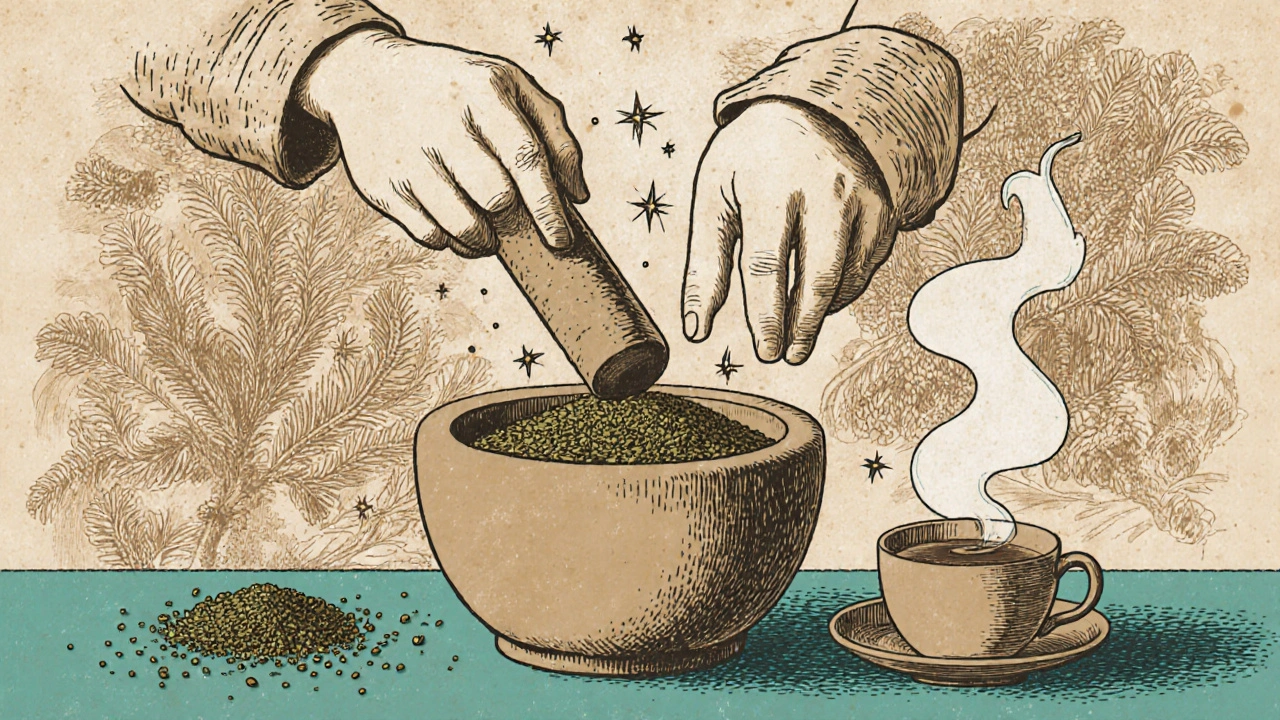Most people think of pine trees when they hear the word "pine"-tall, evergreen giants lining mountain trails. But there’s another kind of pine you’ve probably never heard of, growing low to the ground in damp forests across northern Europe and North America. It’s called ground pine, and for centuries, indigenous healers and herbalists have used it to support respiratory health, ease joint discomfort, and boost circulation. Today, modern science is starting to catch up.
What Exactly Is Ground Pine?
Ground pine (Lycopodium clavatum) isn’t a pine at all. It’s a clubmoss, a type of non-flowering plant that’s been around since the Devonian period-over 380 million years ago. That makes it older than most dinosaurs. Unlike true pines, it doesn’t produce cones or seeds. Instead, it reproduces through tiny spores. You’ll find it in cool, moist woodlands, often tucked under ferns or along shaded stream banks.
Its appearance is deceptively simple: thin, needle-like leaves wrap tightly around a creeping stem, giving it a pine-branch look from a distance. But up close, you’ll notice its dense, emerald-green clusters and the way it forms soft, carpet-like patches on the forest floor. In Europe, it’s sometimes called "stag’s horn clubmoss" because of its upright, branching tips.
Historically, ground pine was harvested for its spores, which were used in medicine, fireworks, and even as a dusting powder for surgical gloves before modern antiseptics. In traditional European herbalism, it was brewed into teas to treat coughs, bladder issues, and kidney stones. Native American tribes used it topically for wounds and internally for digestive complaints.
How Ground Pine Works in the Body
Ground pine contains several bioactive compounds, including alkaloids like lycopodine and huperzine A. These aren’t just random chemicals-they’re active players in how your body functions.
Huperzine A, in particular, has been studied for its ability to inhibit acetylcholinesterase, an enzyme that breaks down acetylcholine-a neurotransmitter critical for memory, focus, and muscle control. That’s why researchers have looked at huperzine A as a potential support for cognitive health. While most supplements now use purified huperzine A extracted from Chinese clubmoss (Huperzia serrata), ground pine naturally contains it too, just in smaller amounts.
But the real magic lies in its anti-inflammatory and diuretic properties. Studies from the 1980s and 90s showed that extracts from Lycopodium species reduced swelling in animal models. This aligns with centuries of folk use for arthritis and gout. The plant also stimulates urine flow, helping flush out excess fluids and toxins-something traditional healers used to relieve bloating and urinary discomfort.
It’s not a miracle cure. But if you’re looking for a gentle, plant-based way to support your body’s natural detox pathways, ground pine has a track record.
How People Use Ground Pine Today
These days, you won’t find ground pine on supermarket shelves. It’s not regulated like pharmaceuticals, and harvesting wild populations can damage fragile ecosystems. That’s why most modern use comes in two forms: dried herb and standardized extracts.
- Teas and tinctures: Dried ground pine leaves are steeped in hot water for 10-15 minutes. One cup a day is common for mild respiratory support or to encourage fluid balance. Tinctures (alcohol-based extracts) are more concentrated and often used for joint discomfort-typically 1-2 mL, two to three times daily.
- Topical salves: Ground pine-infused oils are sometimes blended with calendula or comfrey to make creams for sore muscles and stiff joints. The anti-inflammatory effect is subtle but noticeable over time.
- Homeopathic remedies: In diluted forms, ground pine is used in homeopathy for headaches, vertigo, and digestive cramps. These preparations are so weak they contain virtually no plant material-but many users report benefits.
Important note: Ground pine is not the same as the ornamental "ground pine" sold in garden centers. That’s usually a type of juniper or cypress. Always check the Latin name: Lycopodium clavatum.

What Science Says About Ground Pine
There’s no large-scale clinical trial proving ground pine cures disease. But there’s enough preliminary evidence to suggest it’s worth exploring under the right conditions.
A 2012 study in the Journal of Ethnopharmacology found that extracts from Lycopodium species significantly reduced inflammation markers in lab cultures. Another study from 2018, published in Phytotherapy Research, showed improved mobility in rats with induced arthritis after daily administration of ground pine extract.
What’s more compelling is the consistency of historical use. In Germany, ground pine is officially recognized as a medicinal herb by the Commission E-a government body that evaluates herbal remedies. It’s approved for use in treating mild urinary tract irritation and bronchial congestion.
That’s not the same as saying it works for everyone. But when traditional knowledge meets modern science, and both point in the same direction, it’s worth paying attention.
Who Should Avoid Ground Pine?
Like any herb, ground pine isn’t for everyone. Here’s who should skip it:
- Pregnant or breastfeeding women: There’s not enough safety data. Better to err on the side of caution.
- People with kidney disease: Its diuretic effect could strain already compromised kidneys.
- Those taking prescription diuretics: Combining it with water pills like furosemide could lead to electrolyte imbalances.
- Anyone with a sensitivity to alkaloids: Some people report nausea, dizziness, or mild stomach upset when using ground pine extracts.
Also, don’t harvest it yourself unless you’re an expert. Wild populations are declining due to overharvesting and habitat loss. If you want to try it, buy from reputable herbal suppliers who source sustainably or use cultivated plants.

How to Use Ground Pine Safely
If you’re curious and want to try ground pine, here’s a simple, safe approach:
- Start with a low dose: One cup of weak tea per day for 3-5 days.
- Monitor how you feel: Watch for any digestive upset, dizziness, or changes in urination.
- Don’t use continuously: Take breaks. Try it for two weeks, then pause for a week.
- Pair it with hydration: Drink extra water to support its diuretic action.
- Stop immediately if you feel unwell.
It’s not a quick fix. Ground pine works slowly, like most herbal remedies. You won’t feel a rush of energy or instant relief. But over time, some users report feeling lighter, breathing easier, and moving with less stiffness.
Alternatives to Ground Pine
If ground pine isn’t available or doesn’t suit you, here are other natural options with similar benefits:
- Nettle leaf: A gentle diuretic that supports kidney function and reduces inflammation.
- Horsetail: Rich in silica, used for joint support and tissue repair-similar to ground pine’s traditional use.
- Turmeric: Strong anti-inflammatory, backed by hundreds of clinical studies.
- Huperzine A supplements: If you’re after cognitive support, purified huperzine A from Huperzia serrata is more reliable than ground pine.
None of these are exact replacements, but they’re safer and more accessible for most people.
Final Thoughts: Nature’s Quiet Ally
Ground pine doesn’t scream for attention. It doesn’t have flashy marketing or celebrity endorsements. It just grows quietly in the shadows, doing what it’s done for millennia: helping bodies heal.
Modern life pushes us toward fast, powerful solutions. But sometimes, the gentlest remedies are the ones that last. Ground pine won’t cure your arthritis or clear your lungs overnight. But if you’re looking for a natural way to support your body’s own healing systems-without harsh side effects-it might just be worth a try.
Respect it. Use it wisely. And remember: nature’s most powerful tools are often the ones we’ve forgotten how to see.
Is ground pine safe to use every day?
No, it’s not recommended for daily, long-term use. Ground pine has mild diuretic and alkaloid effects that can build up in the body. Use it in cycles-two weeks on, one week off-to avoid potential side effects like nausea or electrolyte imbalance.
Can ground pine help with asthma?
There’s no strong evidence ground pine treats asthma. While it was historically used for bronchial congestion, modern asthma requires medical management. Don’t replace prescribed inhalers or medications with herbal remedies. Always consult a doctor before using herbs for respiratory conditions.
Where can I buy ground pine safely?
Look for reputable herbal suppliers in the UK or EU that source sustainably harvested or cultivated Lycopodium clavatum. Avoid wild-harvested products unless they’re certified by organizations like FairWild. Online retailers like Herbpharm, Mountain Rose Herbs, and local apothecaries with transparent sourcing are good options.
Does ground pine interact with medications?
Yes. It may interact with diuretics, medications for Alzheimer’s or dementia (like donepezil), and drugs that affect the nervous system. Always talk to your pharmacist or doctor before combining ground pine with any prescription medication.
Why isn’t ground pine more popular?
It’s not patented, so pharmaceutical companies have no financial incentive to promote it. Also, wild populations are declining, making large-scale production difficult. Most people simply don’t know about it-unlike turmeric or echinacea, it’s never been heavily marketed.


Alex Czartoryski
Ground pine? Yeah, I tried it last winter after my cough wouldn’t quit. Didn’t do squat. I mean, sure, it’s ‘ancient’ and ‘natural,’ but so is poison ivy. I’d rather take a Mucinex and call it a day.